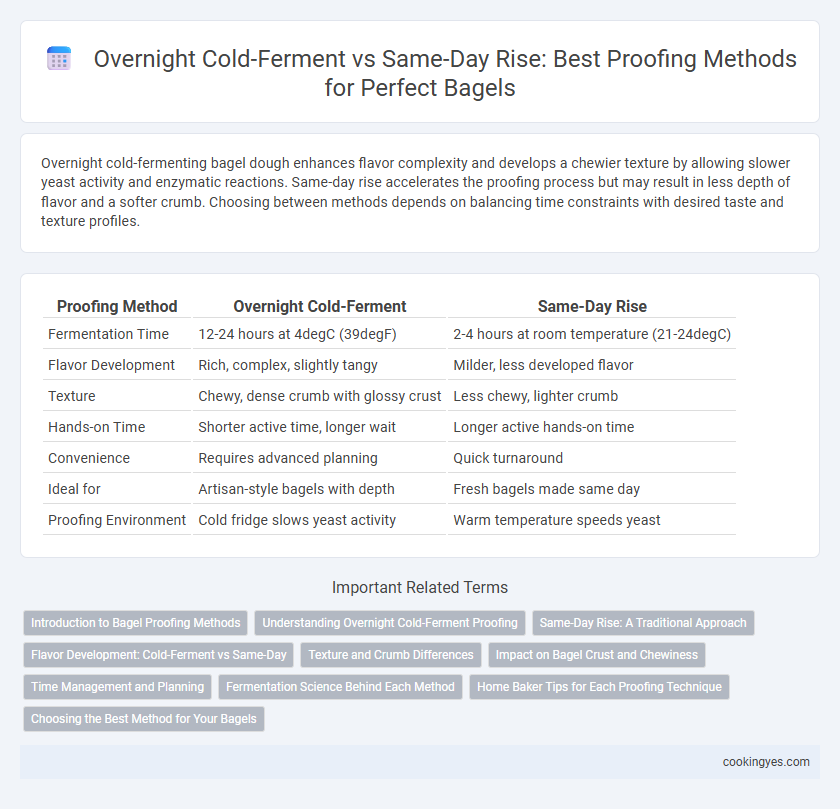Overnight cold-fermenting bagel dough enhances flavor complexity and develops a chewier texture by allowing slower yeast activity and enzymatic reactions. Same-day rise accelerates the proofing process but may result in less depth of flavor and a softer crumb. Choosing between methods depends on balancing time constraints with desired taste and texture profiles.
Table of Comparison
| Proofing Method | Overnight Cold-Ferment | Same-Day Rise |
|---|---|---|
| Fermentation Time | 12-24 hours at 4degC (39degF) | 2-4 hours at room temperature (21-24degC) |
| Flavor Development | Rich, complex, slightly tangy | Milder, less developed flavor |
| Texture | Chewy, dense crumb with glossy crust | Less chewy, lighter crumb |
| Hands-on Time | Shorter active time, longer wait | Longer active hands-on time |
| Convenience | Requires advanced planning | Quick turnaround |
| Ideal for | Artisan-style bagels with depth | Fresh bagels made same day |
| Proofing Environment | Cold fridge slows yeast activity | Warm temperature speeds yeast |
Introduction to Bagel Proofing Methods
Overnight cold-fermentation develops complex flavors and a chewier texture in bagels by slowing yeast activity at temperatures between 35degF to 45degF, resulting in enhanced gluten structure and distinctive tanginess. Same-day rise involves proofing at warmer room temperatures, typically 75degF to 85degF, allowing faster yeast fermentation but producing a milder flavor and a softer crumb. Choosing between these methods depends on desired bagel characteristics, balancing fermentation time, flavor depth, and dough elasticity.
Understanding Overnight Cold-Ferment Proofing
Overnight cold-ferment proofing slows yeast activity by refrigerating the dough for 12 to 24 hours, enhancing flavor complexity through extended enzymatic reactions. This process improves bagel texture, creating a chewier crumb and a crispier crust compared to same-day rise methods. Cold fermentation also allows better gluten development, resulting in higher oven spring and a more authentic bagel chew.
Same-Day Rise: A Traditional Approach
Same-day rise for bagel proofing involves a rapid fermentation process that typically takes 2 to 3 hours, allowing the dough to develop its characteristic chewy texture and glossy crust quickly. This traditional approach relies on higher yeast activity and warmer temperatures to accelerate gluten development and gas retention, resulting in denser, more robust bagels with a classic flavor profile. Bakers favor same-day rise for its efficiency and ability to produce authentic New York-style bagels with a crisp exterior and a chewy interior in a single day.
Flavor Development: Cold-Ferment vs Same-Day
Overnight cold-ferment for bagel proofing enhances flavor development by allowing enzymes to break down starches and proteins slowly, resulting in a complex, tangy taste and improved crust texture. Same-day rise produces a milder flavor with less depth due to the shorter fermentation time limiting enzymatic activity and organic acid formation. Choosing cold-fermentation optimizes flavor complexity, texture, and aroma for traditional bagels.
Texture and Crumb Differences
Overnight cold-fermentation enhances bagel texture by developing a chewier crust and denser crumb due to slow yeast activity and extended gluten strengthening. Same-day rise produces a lighter, airier crumb with a softer crust, as fermentation time is limited, resulting in less complex flavor and texture. Cold-fermented bagels typically have more pronounced tanginess and improved shelf life compared to those proofed within hours.
Impact on Bagel Crust and Chewiness
Overnight cold-ferment enhances bagel crust by developing a thicker, chewier exterior due to slower yeast fermentation and gluten strengthening. Same-day rise produces a lighter crust with less chewiness as the dough ferments quickly, resulting in lower acidity and less gluten development. The cold-fermented dough's extended proofing time also intensifies flavor complexity, contributing to the classic bagel texture prized for its dense, chewy bite.
Time Management and Planning
Overnight cold-ferment in bagel proofing enhances flavor complexity and improves dough texture by allowing a slow yeast activity during extended refrigeration, making it ideal for efficient time management and batch planning. Same-day rise accelerates production, suitable for quick turnaround but may sacrifice depth of taste and chewiness. Prioritizing cold fermentation enables better scheduling flexibility, reducing day-of workload and ensuring consistent product quality.
Fermentation Science Behind Each Method
Overnight cold-fermentation allows enzymes to break down starches more thoroughly, producing complex flavors and a chewy texture in bagels due to slower yeast activity at low temperatures. Same-day rise relies on rapid fermentation, leading to a milder taste and softer crumb as yeast produces carbon dioxide quickly but develops fewer flavor compounds. The extended enzymatic activity in cold fermentation enhances gluten structure and maltose availability, critical for authentic bagel characteristics.
Home Baker Tips for Each Proofing Technique
Overnight cold-ferment bagels develop deeper flavor complexity and a chewier texture due to slow yeast activity in the refrigerator, making them ideal for home bakers seeking rich taste with minimal hands-on time. Same-day rise bagels offer a quicker turnaround with a lighter crumb and softer crust, perfect for beginners or those pressed for time who want fresh bagels the same day. For best results, home bakers should adjust hydration levels and proofing times carefully: cold-fermented dough often requires a longer final proof at room temperature, while same-day dough benefits from a slightly warmer environment to ensure proper rise and oven spring.
Choosing the Best Method for Your Bagels
Overnight cold-fermentation enhances bagel flavor by allowing extended yeast activity and gluten development, resulting in a chewier texture and deeper complexity. Same-day rise accelerates production, producing a softer crumb but may lack the characteristic bite and aroma of cold-fermented bagels. Choosing the best proofing method depends on balancing time constraints with desired texture and flavor intensity.
Overnight cold-ferment vs same-day rise for bagel proofing Infographic

 cookingyes.com
cookingyes.com